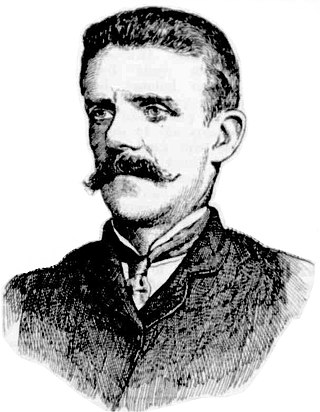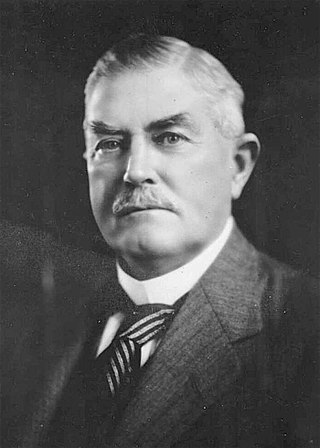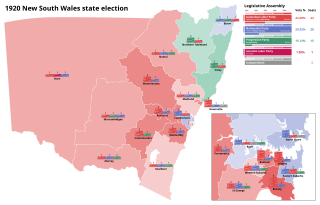Related Research Articles
Members of the New South Wales Legislative Assembly who served in the 53rd parliament held their seats from 2003 to 2007. They were elected at the 2003 state election, and at by-elections. The Speaker was John Aquilina.
Members of the New South Wales Legislative Assembly who served in the 35th parliament held their seats from 1947 to 1950. They were elected at the 1947 state election, and at by-elections. The Speaker was Bill Lamb.
Members of the New South Wales Legislative Assembly who served in the fourth parliament of New South Wales held their seats from 1860 to 1864: The Speaker was Terence Murray until 13 October 1862 and then John Hay.
Members of the New South Wales Legislative Assembly who served in the seventh parliament of New South Wales held their seats from 1872 to 1874. The 182 election was held between 13 February and 28 March 1872 with parliament first meeting on 30 April 1872. There were 72 members elected for 52 single member electorates, 6 two member electorates and 2 four member electorates. The maximum term of this parliament was 3 years. However the assembly was dissolved after 32 months. Henry Parkes was the premier for the duration of the parliament. The Speaker was William Arnold.
Members of the New South Wales Legislative Assembly who served in the ninth parliament of New South Wales held their seats from 1877 to 1880. The 1877 election was held between 24 October and 12 November 1877 with parliament first meeting on 27 November 1877. There were 73 members elected for 53 single member electorates, 6 two member electorates and 2 four member electorates. Premiers during this parliament were Sir John Robertson until 18 December 1877, James Farnell from 18 December 1877 until 21 December 1878 and Sir Henry Parkes from 21 December 1878. The Speaker was Sir George Allen.
Members of the New South Wales Legislative Assembly who served in the 10th parliament of New South Wales held their seats from 1880 to 1882. Elections for the tenth Legislative Assembly were held between 17 November and 10 December 1880 with parliament first meeting on 15 December 1880. Electoral reforms passed by the ninth parliament had resulted in parliament being expanded to 108 members elected in 43 single member electorates, 25 two member electorates, 1 three member electorate and 3 four member electorates. In addition, electorates franchised on qualifications of occupation or education had been abolished. The parliament had a maximum term of 3 years but was dissolved after 23 months. Sir Henry Parkes continued as the Premier for the duration of the parliament. The Speaker was Sir George Allen.
Members of the New South Wales Legislative Assembly who served in the 11th parliament of New South Wales held their seats from 1882 to 1885. Elections for the eleventh Legislative Assembly were held between 30 November and 21 December 1882 with parliament first meeting on 3 January 1883. The Assembly was expanded to 113 members elected in 40 single member electorates, 26 two member electorates, 3 three member electorate and 3 four member electorates. The parliament had a maximum term of 3 years and was dissolved on 7 October 1885 after 33 months. The Premiers during this parliament were Sir Alexander Stuart until 7 October 1885 and then George Dibbs. The Speaker was Edmund Barton.
Members of the New South Wales Legislative Assembly who served in the 25th parliament of New South Wales held their seats from 1920 to 1922. They were elected at the 1920 state election on 20 March 1920. The Speaker was Daniel Levy with the exception of 13–20 December 1921 when he was replaced by Simon Hickey.
Members of the New South Wales Legislative Assembly who served in the 24th parliament of New South Wales held their seats from 1917 to 1920. They were elected at the 1917 state election on 24 March 1917. Speaker was John Cohen until 19 August 1919 when he was succeeded by Daniel Levy.

Alfred Edden was a politician, trade union organiser and coal miner in New South Wales, Australia. He was a member of the New South Wales Legislative Assembly for more than 28 years, including 3 as Secretary for Mines. He was a foundation member of the Labor Party but left the party twice, in 1891 over the question of the solidarity pledge and was expelled in 1916 over the question of conscription.
Sydney, an electoral district of the Legislative Assembly in the Australian state of New South Wales, has had two incarnations, the first from 1920 to 1927 as a five-member electorate, the second from 2007 to the present as a single-member electorate.

The Holman ministry , also known as the Second Holman ministry or Holman Nationalist ministry was the 36th ministry of the New South Wales Government, and was led by the 19th Premier, William Holman.
Patrick Joseph Minahan, was an Irish-born Australian politician.

The 1922 New South Wales state election was held on 25 March 1922. This election was for all of the 90 seats in the 26th New South Wales Legislative Assembly and it was conducted in multiple member constituencies using the Hare Clark single transferable vote. The 25th parliament of New South Wales was dissolved on 17 February 1922 by the Governor, Sir Walter Edward Davidson, on the advice of the Premier James Dooley.
This is a list of candidates for the 1922 New South Wales state election. The election was held on 25 March 1922. The election was the second of three conducted under the system of proportional representation.

The 1920 New South Wales state election was held on 20 March 1920. The 24th parliament of New South Wales was dissolved on 18 February 1920 by the Governor, Sir Walter Edward Davidson, on the advice of the Premier William Holman. The election was for all of the 90 seats in the 25th New South Wales Legislative Assembly, and it was the first to be conducted with multi-member electorates, using the Hare-Clark single transferable vote system.

The 1904 New South Wales state election was held on 6 August 1904 for all of the 90 seats in the 20th New South Wales Legislative Assembly and it was conducted in single-member constituencies with a first past the post voting system. For the first time, women were entitled to vote. Both adult males and females were entitled to vote, but not Indigenous people. The 19th parliament of New South Wales was dissolved on 16 July 1904 by the Governor, Sir Harry Rawson, on the advice of the Premier, Thomas Waddell.

The 1901 New South Wales state election was held on 3 July 1901 for all of the 125 seats in the 19th New South Wales Legislative Assembly and it was conducted in single-member constituencies with a first past the post voting system. The Parliamentary Electorates Act of 1893 had conferred the right to vote on every male British subject over 21 years of age who was resident in New South Wales for a year or more. The 19th parliament of New South Wales was dissolved on 11 June 1901 by the Governor, Lord Beauchamp, on the advice of the Premier, John See.
The 1904 New South Wales state election was held on 6 August 1904. It involved 90 electoral districts returning one member each, a reduction from 125 to 90. Women were given the right to vote for the first time in New South Wales elections, almost doubling the number of enrolled voters. As a result, it is not possible to tell the notional holder of a seat prior to the election.
Eastern Suburbs, an electoral district of the Legislative Assembly in the Australian state of New South Wales was created in 1920 and abolished in 1927.
References
- ↑ "The ALP: definite action taken against candidates who sign pledges". The Sydney Morning Herald . 10 March 1920. p. 11. Retrieved 2 November 2019– via National Library of Australia.
- Green, Antony. "1920 election candidate index". New South Wales Election Results 1856-2007. Parliament of New South Wales . Retrieved 2 November 2019.